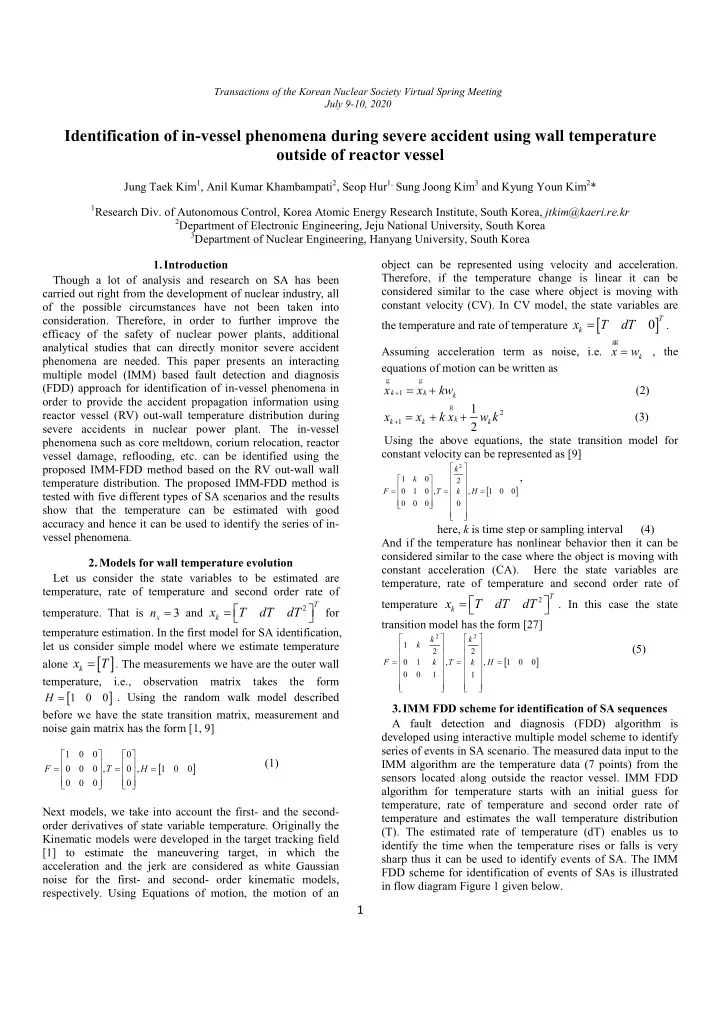

Transactions of the Korean Nuclear Society Virtual Spring Meeting July 9-10, 2020 Identification of in-vessel phenomena during severe accident using wall temperature outside of reactor vessel Jung Taek Kim 1 , Anil Kumar Khambampati 2 , Seop Hur 1, Sung Joong Kim 3 and Kyung Youn Kim 2 * 1 Research Div. of Autonomous Control, Korea Atomic Energy Research Institute, South Korea, jtkim@kaeri.re.kr 2 Department of Electronic Engineering, Jeju National University, South Korea 3 Department of Nuclear Engineering, Hanyang University, South Korea 1. Introduction object can be represented using velocity and acceleration. Therefore, if the temperature change is linear it can be Though a lot of analysis and research on SA has been considered similar to the case where object is moving with carried out right from the development of nuclear industry, all constant velocity (CV). In CV model, the state variables are of the possible circumstances have not been taken into consideration. Therefore, in order to further improve the T x T dT 0 the temperature and rate of temperature . k efficacy of the safety of nuclear power plants, additional g g analytical studies that can directly monitor severe accident x w Assuming acceleration term as noise, i.e. , the k phenomena are needed. This paper presents an interacting equations of motion can be written as multiple model (IMM) based fault detection and diagnosis g g (FDD) approach for identification of in-vessel phenomena in x x kw (2) k 1 k k order to provide the accident propagation information using 1 g reactor vessel (RV) out-wall temperature distribution during 2 x x k x w k (3) k k 1 k k 2 severe accidents in nuclear power plant. The in-vessel Using the above equations, the state transition model for phenomena such as core meltdown, corium relocation, reactor constant velocity can be represented as [9] vessel damage, reflooding, etc. can be identified using the proposed IMM-FDD method based on the RV out-wall wall 2 k , 1 k 0 temperature distribution. The proposed IMM-FDD method is 2 F 0 1 0 , T k , H 1 0 0 tested with five different types of SA scenarios and the results 0 0 0 0 show that the temperature can be estimated with good accuracy and hence it can be used to identify the series of in- here, k is time step or sampling interval (4) vessel phenomena. And if the temperature has nonlinear behavior then it can be considered similar to the case where the object is moving with 2. Models for wall temperature evolution constant acceleration (CA). Here the state variables are Let us consider the state variables to be estimated are temperature, rate of temperature and second order rate of temperature, rate of temperature and second order rate of T 2 x T dT dT temperature . In this case the state T n x T dT dT 2 k 3 temperature. That is and for k x transition model has the form [27] temperature estimation. In the first model for SA identification, 2 2 k k let us consider simple model where we estimate temperature 1 k (5) 2 2 x T . The measurements we have are the outer wall alone F 0 1 k , T k , H 1 0 0 k 0 0 1 1 temperature, i.e., observation matrix takes the form H . Using the random walk model described 1 0 0 3. IMM FDD scheme for identification of SA sequences before we have the state transition matrix, measurement and A fault detection and diagnosis (FDD) algorithm is noise gain matrix has the form [1, 9] developed using interactive multiple model scheme to identify series of events in SA scenario. The measured data input to the 1 0 0 0 (1) IMM algorithm are the temperature data (7 points) from the F 0 0 0 , T 0 , H 1 0 0 sensors located along outside the reactor vessel. IMM FDD 0 0 0 0 algorithm for temperature starts with an initial guess for temperature, rate of temperature and second order rate of Next models, we take into account the first- and the second- temperature and estimates the wall temperature distribution order derivatives of state variable temperature. Originally the (T). The estimated rate of temperature (dT) enables us to Kinematic models were developed in the target tracking field identify the time when the temperature rises or falls is very [1] to estimate the maneuvering target, in which the sharp thus it can be used to identify events of SA. The IMM acceleration and the jerk are considered as white Gaussian FDD scheme for identification of events of SAs is illustrated noise for the first- and second- order kinematic models, in flow diagram Figure 1 given below. respectively. Using Equations of motion, the motion of an 1
Recommend
More recommend